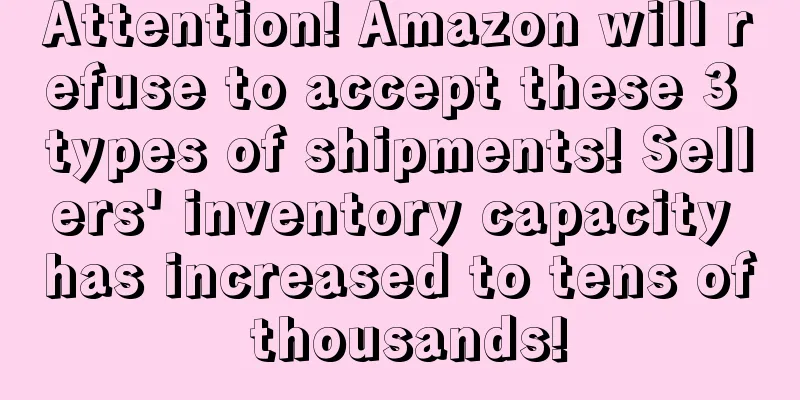|
"The product is obviously not priced high and has good value for money, but after entering the e-commerce platform (Taobao, JD.com, Pinduoduo, etc.), users just can't find the product on the shelves?" I believe this is a problem that many e-commerce sellers often encounter and reflect on late at night. Users just can't find the products they put on the shelves, and the order volume is pitifully small. Some people even switch to running small stalls. What should I do? Why can't I get my products on the homepage of the search bar despite my efforts? This article will take you to find out. Getting rich overnight is not out of reach in the e-commerce world, especially in cross-border e-commerce. Once a hit product is on the front page, it may allow you to quickly achieve financial freedom in just a few days. According to Amazon's official statistics, the traffic on the first three pages of Amazon can account for 70% of the total traffic! Most of Amazon's customers shop through search. They tend to only look at the first few pages of products. Once your keywords are on the homepage, they will get a lot of exposure, and the probability of users buying your products is very high. This tells us how important keywords are in Amazon's operations! Let's take winter down jackets as an example and search on Amazon to see the sales of the top products. The above search results show that top sellers can easily sell tens of thousands of products, and Amazon has a larger profit margin than other e-commerce platforms. The difficulty lies in that many sellers' stores cannot be seen by buyers on the homepage. However, some sellers' category ranking pages are average, but their keyword search rankings are very high. How do they do it? Below I will use actual cases to share with you how to effectively and quickly improve Amazon keyword rankings, and how to optimize keywords to get into the top rankings. 1. Improve Amazon keyword rankings 1.1 Mastering Amazon’s new algorithm Amazon has always hoped to increase the number of sellers and promote competition, which is a constant driving force for platform innovation. It also hopes that competition will always exist so that it can strive to provide better and lower-priced products, that is, to improve the cost-effectiveness of products and provide users with things that are more suitable for them. If you want to improve keyword rankings on Amazon and gain product exposure, you first need to understand Amazon's ranking mechanism. The most critical one is Amazon's A10 algorithm. The A10 algorithm is basically synchronized with A9 and can be understood as an optimized version of A9. The key difference is that the weights of certain parameters are different. Since 2020, sellers have found that their product search rankings have changed several times. This is because Amazon realized that buyers tend to search for products that sellers are not promoting. Therefore, Amazon changed to the new A10 algorithm to make search results more relevant to buyers. Compared with the A9 algorithm, A10 pays more attention to user behavior and places more emphasis on off-site traffic and internal conversion. This also sends us a message that everyone can use their own methods to bring traffic to their own products. Similar channels include blog recommendations, publishing discount information and links, and product soft articles, etc. This is a bit like "Eight Immortals Crossing the Sea, Each Showing Their Magical Powers". 1.2 Factors Affecting the A10 Algorithm From the above figure we can see the influencing factors, among which the more critical ones are: So what do we as sellers need to do? 1. Use PPC advertising to improve keyword rankings In the new Amazon A10 algorithm, PPC is still one of the important driving factors affecting Amazon SEO. As we all know, the advertising costs of Amazon sellers account for a relatively large proportion of the cost. Anyone who has been operating Amazon for a period of time will encounter a situation where my advertising sales are very good and account for a high proportion, but the natural search ranking has not been in the top few pages. This may be because the weight of your product search ranking is declining. Although PPC will still allow your product to reach a sales peak at a certain stage. In order to adapt to Amazon’s changes, we still run PPC campaigns as before, but try a variety of advertising plans, increase the conversion rate of organic orders through operational techniques, constantly adjust the budget, and reduce the proportion of advertising orders. This will most likely produce unexpected gains and surprises. So, here comes the point, how to improve the natural ranking of keywords through PPC advertising? Currently, Exact Match Advertising is the most direct way to influence the natural ranking of keywords. Step 1 : Expand your product keywords Assuming we are a clothing merchant, here we take the down jackets of this season as an example for analysis. Enter "Down jacket" in the Amazon product navigation bar, and the two products found are hot-selling products. The ASIN of one of the down jacket competitors is B013LAZ3A2. Enter the ASIN into the keyword search toolbar of AmzChart, and 704 keywords are found. Then we exported all the keywords to Excel and filtered out three categories of words based on search volume, monthly search popularity and other information: 1) Keywords that are highly related to the product. These keywords are suitable for advertising and listing writing, and should be prioritized for Amazon keyword ranking optimization. 2) Keywords that are highly relevant to the product should be added to the listing. If you plan to advertise, you should give them a lower priority and set a low bid. 3) High Funnel keywords that are not related to the product but belong to the same usage scenario can appear on the product page as a supplementary product. We can consider adding the high search volume keywords in category 3) to the listing or product description. If the budget is sufficient, you can also create Phrase or Exact matching ads and set the bid low. Step 2 : Monitor competitor rankings After we export all keyword data, we filter out words with very low search volume. After we check the keywords related to the keyword, we can use the keywords recommended by AmzChart to optimize our listing or PPC advertising, and we can also use it to find related market segments. Then we import the ASIN of the competitor's high-quality keywords into the AmzChart keyword ranking monitoring tool. The product monitoring function monitors products from the dimensions of the number of sellers, sales, BSR, and the number of comments/bad reviews, and actively tracks competitors' movements every day, so that sellers can follow up on their strategies in a timely manner. Step 3. Check and improve keyword rankings We use our own products to compare with competitors to see how many of your new products are ranked on the homepage and how many of your competitors are ranked on the homepage. Consider how many reviews your competitor's listing has, and how many reviews your new product still has. Through comparative analysis, you will know more clearly which keywords should be prioritized to improve the natural ranking, and you can monitor the changes in the ranking of competitors over a long period of time. If you have already advertised for your new product, you can download the search term report, filter out the keywords that have order conversions, add them to the keyword list, and analyze their natural rankings. Finally, add these keywords to the advertising campaign. 2. Organic sales Sales generated from natural search is one of the important factors affecting Amazon's SEO algorithm. When users purchase our products by searching for them themselves, it is considered a natural sale. This type of sales that does not require any promotional means can significantly save Amazon advertising and promotion fees. If we can optimize the listing to the greatest extent and select the right keywords, the natural sales will be very stable. 3. External Sales The new algorithm increases the weight of external sales. Attracting external traffic to your Amazon products has a higher weight than PPC. Amazon has always hoped to increase the number of sellers and promote competition, which is a constant driving force for innovation. Amazon hopes that competition will always exist so that it can strive to provide better and lower-priced products, that is, improve cost-effectiveness and provide users with something more suitable for them. This is also related to Amazon's strategy of reducing the cost of traffic acquisition, allowing sellers to show their skills and make money for themselves in their own way. Of course, it is also working for Amazon. And we also need to find accurate traffic, which will increase your product conversion rate, thereby affecting the ranking and increasing your weight on Amazon. Therefore, to do a good job of off-site advertising, you can adopt some appropriate strategies: increase the intensity of Facebook or YouTube advertising, or push coupons on targeted user platforms, or even market your own products in product blogs or videos. 4. How to master new algorithms- Increase referral traffic sources;
- Maintain review star rating and count;
- Reasonable use of bullet, description, Q&A, Review, A+ layout keywords;
- Increase external accurate traffic - product usage review articles and videos are the most effective way to attract traffic;
- Optimize the product details page, choose a drawn picture as the main picture, and use a more lifestyle picture to show the features of your product.
2. Optimize listing keywords You need to do the following:- Keywords are preferably words or phrases;
- Do not separate keywords with commas or quotation marks, but with spaces.
- There is no need to repeat the keywords that appear in the title when filling in the keywords, as this will not increase the chance of being searched.
- The words in the product name should be arranged according to certain rules and written in the correct order according to the English description.
- You need to constantly experiment and adjust the keywords of your products to optimize your keywords.
- Refer to the listings of your peers and analyze the keywords of your competitors. Think about how they describe their products, how they set their titles, and what keywords they use.
2.1 Research Platform If you want to improve your keyword ranking on Amazon, you still need to study the dynamics on Amazon. The search box on the Amazon homepage will give us some hints and automatically fill in keywords. For example, I entered the word "Down jacket" on the homepage, and several related keywords appeared below. This is the list of hints generated by Amazon's backend based on the recent hot searches, so it is very likely that the hint keywords you search this week and next week will be different. 2.2 Use tools Similarly, making good use of third-party Amazon tools is also a good choice. The AmzChart tool has many features, such as: View the product industry path and ranking trend, which shows the BSR change trend of the product in the past 30 days; Follow-up sales monitoring: When the follow-up sales information of the products you monitor changes, AmzChart will send you an alert reminder via email; ASIN reverse lookup/keyword query. ASIN query list page, through ASIN search, you can jump to the list page of the ASIN query, which displays the queried keywords, as well as the corresponding monthly search volume and monthly search popularity; click to switch variants and view the keyword information of the variants; click the monitoring button to add it to the product monitoring, click to view details to view the details of the product; click keywords to view keywords and conduct a keyword query, and jump to the keyword query page; 2.2—1. Google Keyword Planner Google Trends generally captures a series of random data, which has a low reference value, while Google Keyword Planner's keyword analysis is more precise. Its filtering and sorting functions will help us find substitutes or competing products more quickly. Using the Google Keyword Planner tool, we can see these data:- The search volume, competitiveness, search frequency, and their changing trends of each keyword and their performance in different regions -
- Related keywords suggested by Google
- Price per click O Daily budget suggestion (if you need to add keywords to your plan list first)
So, how do we use Google Keyword Planner to research keywords? Let me take the keyword "shoe case" as an example. Step 1: Log in to the website with your Google Ads account Step 2: Enter keywords and display search results (the location and language at the top can be changed, just choose according to your target user characteristics) In fact, there are many keyword search tools on the market now, and I cannot guarantee that these tools are 100% perfect. In many cases, you need to constantly test and adjust, combine different methods, and then find the most suitable one for yourself. Sellers should not be too hasty in improving keyword rankings, because Amazon is a platform suitable for deep cultivation. Even if you are an operational expert, it is difficult to achieve immediate results in the short term. In addition to considering the comprehensive factors of Listing, you must also do a good job of optimization, conversion rate, Review, etc. Only when most of the defects are improved, the ranking of keywords will gradually rise. Finally, it has to be said that Amazon is a customer-first platform that puts customer experience above everything else. According to Amazon, the faster consumers find products, the better their shopping experience will be. This perfectly reflects the concept that customers are God, so the platform will be extremely strict with sellers. Only by following the platform rules, constantly adapting to it, learning it, and improving operating skills and methods, can we operate our own stores with ease and create popular products.
|










